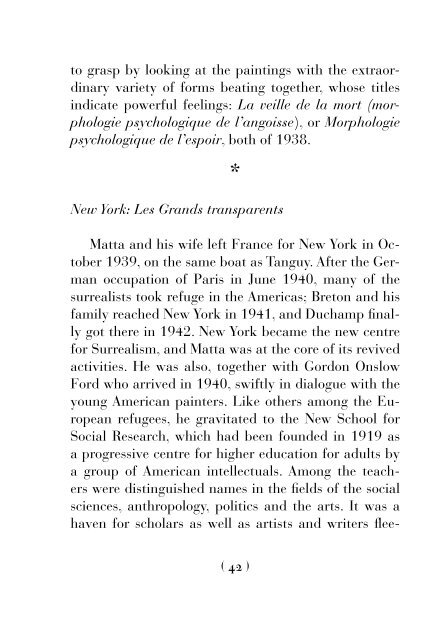Matta-Duchamp
Illustrated catalog featuring full page color illustrations and rare documentary photographs. Published by Galerie Gmurzynska in June 2018 to accompany a special cabinet exhibition at Art Basel 2018. The book includes texts by Professor Dawn Adès and Norman Rosenthal. It coincides with a broader re-evaluation of the importance of Matta internationally as well as of the influence of Duchamp on the work of 20th century artists. Edited and introduced by Krystyna Gmurzynska and Mathias Rastorfer. Essays by Dawn Adès and Norman Rosenthal. Historic interview excerpt by Robert Motherwell. 90 pages with 7 illustrations. Softcover. ISBN: 978-3-905792-09-6
Illustrated catalog featuring full page color illustrations and rare documentary photographs.
Published by Galerie Gmurzynska in June 2018 to accompany a special cabinet exhibition at Art Basel 2018. The book includes texts by Professor Dawn Adès and Norman Rosenthal. It coincides with a broader re-evaluation of the importance of Matta internationally as well as of the influence of Duchamp on the work of 20th century artists.
Edited and introduced by Krystyna Gmurzynska and Mathias Rastorfer.
Essays by Dawn Adès and Norman Rosenthal.
Historic interview excerpt by Robert Motherwell.
90 pages with 7 illustrations.
Softcover.
ISBN:
978-3-905792-09-6
You also want an ePaper? Increase the reach of your titles
YUMPU automatically turns print PDFs into web optimized ePapers that Google loves.
to grasp by looking at the paintings with the extraordinary<br />
variety of forms beating together, whose titles<br />
indicate powerful feelings: La veille de la mort (morphologie<br />
psychologique de l’angoisse), or Morphologie<br />
psychologique de l’espoir, both of 1938.<br />
*<br />
New York: Les Grands transparents<br />
<strong>Matta</strong> and his wife left France for New York in October<br />
1939, on the same boat as Tanguy. After the German<br />
occupation of Paris in June 1940, many of the<br />
surrealists took refuge in the Americas; Breton and his<br />
family reached New York in 1941, and <strong>Duchamp</strong> finally<br />
got there in 1942. New York became the new centre<br />
for Surrealism, and <strong>Matta</strong> was at the core of its revived<br />
activities. He was also, together with Gordon Onslow<br />
Ford who arrived in 1940, swiftly in dialogue with the<br />
young American painters. Like others among the European<br />
refugees, he gravitated to the New School for<br />
Social Research, which had been founded in 1919 as<br />
a progressive centre for higher education for adults by<br />
a group of American intellectuals. Among the teachers<br />
were distinguished names in the fields of the social<br />
sciences, anthropology, politics and the arts. It was a<br />
haven for scholars as well as artists and writers flee-<br />
( 42 )

















